If you’re unable to connect to the internet on your Windows 11 or Windows 10 computer due to Wi-Fi problems, and when you run the Internet Connections Troubleshooter, you see the message The connection between your access point, router or cable modem and the Internet is broken displayed in the Windows Network Diagnostics report, then this post is intended to help you with solutions to resolve the issue.
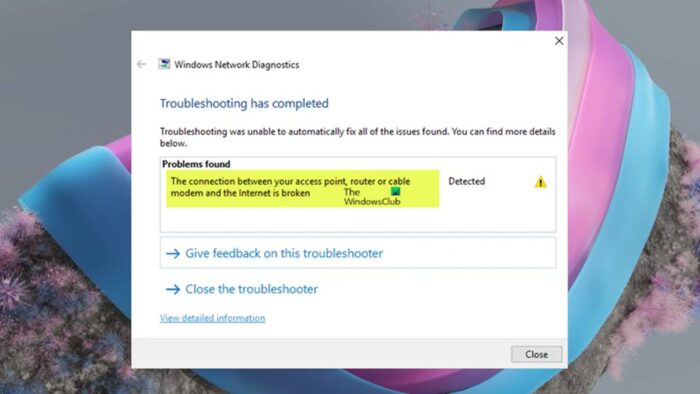
The connection between your access point, router, or cable modem and the Internet is broken
If the Windows Network Diagnostics report displays the message The connection between your access point, router, or cable modem and the Internet is broken after you run the Internet Connections Troubleshooter in an attempt to fix internet issues that you may be experiencing on your Windows 11/10 PC, then our suggestions as provided below should help you resolve the issue on your system.
- Reposition your internet device (modem/router)
- Reboot your internet device (router/modem) and PC
- Check for the internet outage
- Make sure internet device firmware and Windows are updated
- Make sure the Wi-Fi network adapter driver is updated
- Temporarily disable security software
- Connect with an Ethernet cable
- Reset the internet device to default settings
- Reset the Wi-Fi network adapter
- Run Hardware and Devices Troubleshooter
- Use an external Wi-Fi adapter USB dongle
- Contact your Internet Service Provider
Read: Fix Network & Internet connection problems in Windows 11/10
Let’s look at the description of the process as it relates to each of the listed solutions.
1] Reposition your internet device (modem/router)
It’s likely an error The connection between your access point, router, or cable modem and the Internet is broken occurs due to the location of your internet device. So, you can begin troubleshooting the issue by repositioning your internet device. Moving a Wi-FI router two or three meters across a room can make a huge difference when trying to get the best coverage in your house/office. Make sure your Wi-Fi router is placed centrally in your house. To move your modem, follow these steps:
- Turn the modem off or unplug the device from the mains.
- Disconnect the modem from your router or other hardware.
- Move the modem to the new location.
- Reconnect your modem to a coaxial connector or phone jack and plug back in any other equipment like your router.
2] Reboot your internet device (router/modem) and PC
Your next line of action to troubleshoot the issue at hand is to simply restart your internet device by unplugging it, waiting 10 seconds or so, plugging it back in, and allowing it to reboot. More often than not, this will resolve your home internet connection outage which is most likely due to a hiccup with your modem and/or router.
If you want to restart your router, you can do so by cutting power by unplugging the device instead of pressing or holding any buttons on the device itself as this can prompt the device to do a hard reset and restore to factory settings and erase your Wi-Fi network settings. Albeit the reset will likely re-establish your internet connection, you’ll now have to configure your Wi-Fi router settings all over again. During the reboot if the lights on your modem or router don’t go out when you unplug it from the mains, your device may have a battery backup, so check to see if there are batteries installed somewhere and temporarily remove them when restarting your device.
Similarly, you can also reboot your PC to clear any connection interference between your Windows 11/10 computer and your modem and/or router. Even though other devices can connect to the Wi-Fi network without issues, rebooting the internet device and the PC you’re having issues on may resolve the issue.
Read: Why does restarting your Windows PC fix so many problems?
3] Check for internet outage
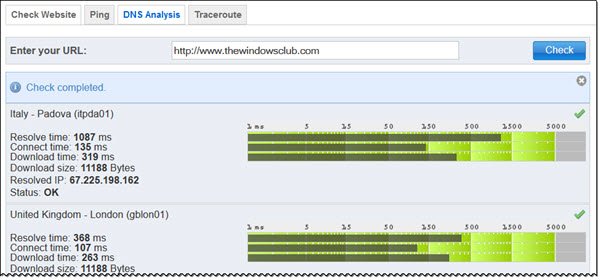
From time to time there may be planned maintenance or unforeseen incidents that may cause an outage and affect your service. So, if your internet is completely out and you’ve already tried restarting the router, check your provider’s social media pages, official website, or sources like downdector.com (a free online website that monitors to check if the website is down or not) for updates and outage reports. If there’s indeed an outage at your ISP end, there’s nothing you can do in such situations other than wait for service to return which is usually in a couple of minutes/hours.
Read: How to fix Unidentified Network in Windows 11/10
4] Make sure internet device firmware and Windows are updated
All software and devices contain vulnerabilities and need to be updated whenever an update is available. While most routers automatically update their firmware, it’s still good to check it manually periodically. Routers may have software patches created to improve the security and functionality of the device. This firmware must be upgraded to the latest version when released. You can search the instructions for your router firmware update procedure through the support website offered by your device manufacturer. Make sure you search for the exact model number to update your router’s firmware to keep your devices working properly and improve your security.
Similarly, you should check for updates and install any available bits on your Windows 11/10 device. If your internet device and PC are updated but the issue in the highlight isn’t resolved, you can proceed with the next solution.
5] Make sure the Wi-Fi network adapter driver is updated
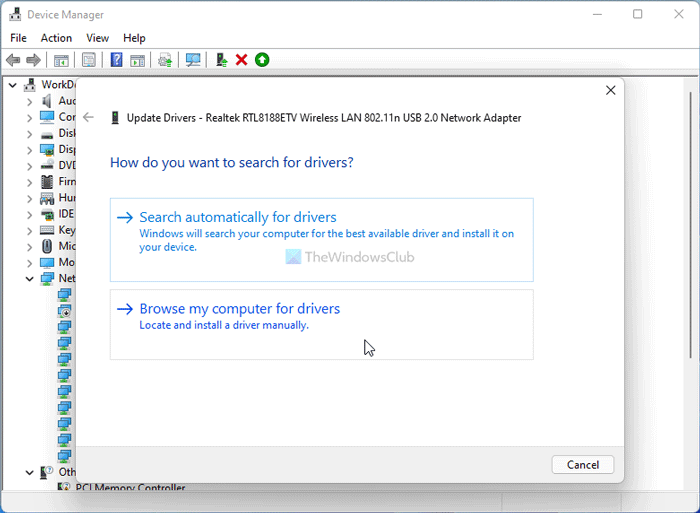
This solution requires you to make sure the Wi-Fi network adapter driver is updated. You can perform this task using any of the following methods below:
- Manually update drivers via Device Manager if you have already downloaded the .inf or .sys file for the driver.
- Update driver via Command Prompt.
- Get the driver updates on the Optional Updates section under Windows Update.
- Download the latest version of the driver from the network adapter manufacturer’s website.
- Automatically update your drivers using any of the free Driver Update Software for Windows 11/10 PC.
If the latest drivers are already installed, you can roll back the driver or download and install an earlier version of the driver. If both updating and/or rolling back the driver didn’t work, you can uninstall the Wi-Fi network adapter driver, and then restart your PC – on boot, Windows will scan for hardware changes and automatically reinstall the generic driver for the device.
6] Temporarily disable security software
This is a viable solution to the issue in focus. So, if you have confirmed that all the network settings are configured correctly but you still have an internet connection problem, you can try disabling the firewall temporarily and check if the PC connects to the internet. Another issue could be your installed antivirus or malware protection software. If you have installed third-party security software, try to disable the software temporarily and test your connection.
7] Connect with an Ethernet cable
Although this has its limitations which is mobility as no matter how long the cable is, your best bet for establishing and maintaining a strong and stable connection between your PC and your internet device is by connecting directly to your modem, router, or pods/extenders using an Ethernet cable. If possible, use a wired connection for the most bandwidth-hogging devices, like smart TVs and gaming consoles. Not only will this often provide a better, faster connection, but it will also take some of the strain off your Wi-Fi network.
Read: WiFi working but Ethernet not working in Windows 11/10
8] Reset the internet device to default settings
You can easily reset your router or modem to its factory settings when your internet connectivity starts acting up. Keep in mind that resetting your router will completely wipe any configurations you’ve saved and restore your router to its factory default router settings, and a factory reset can take several minutes and will interrupt your internet access. For most modern routers (refer to the device user manual), doing a complete factory reset requires only a few steps as follows:
- Make sure your router is plugged in.
- Find the reset button (usually inside a tiny hole on the back).
- Insert a paperclip into the hole to hold down the button for 30 seconds.
- Release the button and wait for your router to power back on.
After the reset, you’ll need to set up your devices again. If your router doesn’t have a reset button, you can still reset it to factory settings by logging in via the web interface. Most routers also allow you to back up your settings from the web interface. To reset your router through the web interface, follow these steps:
- Find your router’s IP address.
- Type the address into your browser.
- Log in using your username and password.
- Find the factory reset option (usually found under Settings or System).
If you saved your settings before resetting, the option to restore those settings is usually located in the same menu.
9] Reset the Wi-Fi network adapter
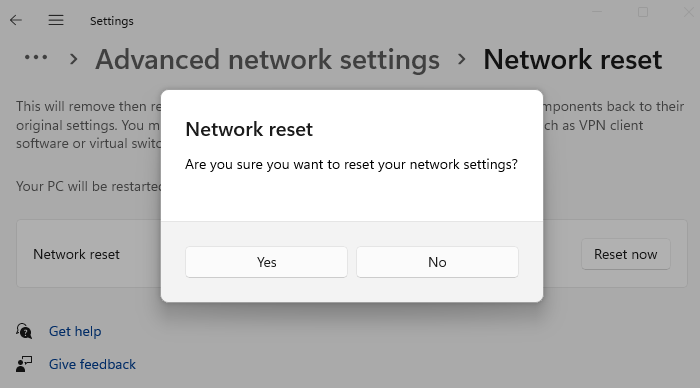
You might be experiencing this issue because of a configuration error or an outdated device driver. Installing the latest driver for your device is usually the best policy because it has all the latest fixes. But in the case updating the network adapter didn’t work, you can reset the Wi-Fi network adapter. A network reset will remove and reinstall all network adapters on your computer as well as set most other networking components back to their original settings.
10] Run Hardware and Devices Troubleshooter
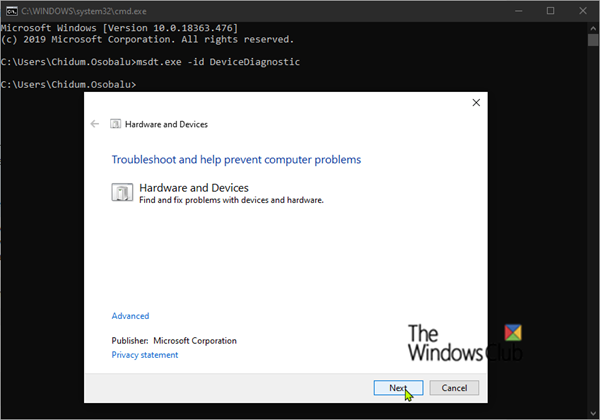
To rule out faulty PC hardware like the network adapter as the culprit to the issue you’re currently dealing with, you can run the Hardware and Devices Troubleshooter to fix problematic devices. If need be, you may have to engage the services of a PC hardware technician to repair or replace any faulty hardware detected.
Read: Windows did not detect any networking hardware
11] Use an external Wi-Fi adapter USB dongle
Also known as a Wi-Fi dongle, Wi-Fi stick, internet stick or USB network adaptor, a dongle is a small modem that allows you to access 3G, 4G or 5G data (depending on your dongle plan) by plugging it into a USB port on the device you’re using. A USB Wi-Fi adapter eliminates the need to hardwire the computer to a router or other network device and it overrides the computer’s built-in wireless functionality, giving you a faster, more reliable connection to your available network signals.
Read: Can’t connect to this network WiFi error in Windows 11/10
12] Contact your Internet Service Provider
If you have exhausted evry other options but the issue is still not resolved, you need to contact your Internet Service Provider (ISP) to find out whether the problem could be at their end. Some ISP may block you from accessing the internet if you are in breach of their terms and conditions or your subscription has expired, and you haven’t renewed your plan yet.
I hope you find this post helpful!
Now read: Security or Firewall might be blocking the connection
How do I fix my broken internet connection?
If your internet connection is broken, you can resolve the issue by applying these common fixes:
- Restart your router.
- Switch Wi-Fi bands (2.4 GHz and 5 GHz).
- Test your Wi-Fi on different devices.
- Try a different Ethernet cable.
- Improve the position of your device and/or router.
Why does my WiFi access point keep disconnecting?
If your WiFi access point keep disconnecting, then it indicates you or your internet provider need to resolve one or more issues. For example, your modem may be faulty, your router firmware may be outdated, or you may have too many devices using too much data simultaneously. Also, it could be that cables are damaged. Another reason is that network congestion can potentially slow speeds.
Read: Difference between Wireless Router and Wireless Access Point
That’s all! Hope this guide worked for you.